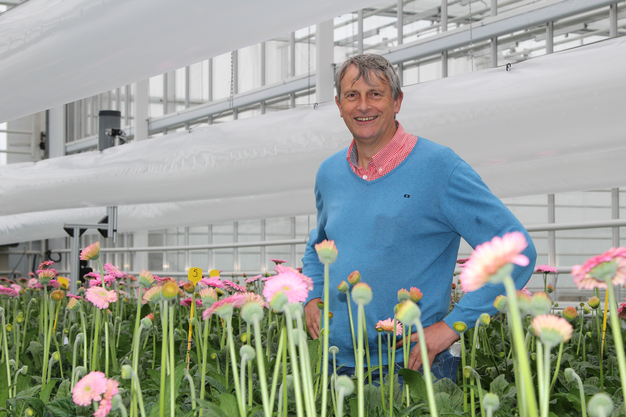Since the summer of 2023, Wageningen University & Research has been conducting a trial with reverse air circulation in gerbera cultivation. An adapted AVS-C installation from Van Dijk Heating facilitates the process in which dry air is blown in above the crop. Underneath the cultivation gutters are pipes with holes, which extract moist air from the greenhouse. The downward dry air stream reduces the chances of transpiration moisture condensing on the flower, which is a cause of quality issues.
Driven by high energy prices, many growers have traded their HPS lamps for more efficient LED installations in recent years. But these emit less radiant heat. Many have also lowered their heat and lighting input to cut costs. The downside of these understandable actions is that in the early morning, when the crop temperature is still low, moisture condenses on parts of the crop more often. Then moisture-loving fungi, such as Botrytis, have a better chance of infecting crops. "Many gerbera growers have struggled with this and still do," says researcher Frank Kempkes. "A Botrytis blight in the flower can cause what is called 'crown rot,' which makes the flower worthless. It's a moisture-related problem."
Kas als Energiebron
With funding from the Kas als Energiebron (Greenhouse as an Energy Source) program, a trial was set up last year as part of the Greenhouse 2030 project to gain more insight into the problem and possible solutions for better moisture control. In a mid-term evaluation with Ton van Dijk, who is involved in the project on behalf of Van Dijk Heating, Kempkes and his colleague Tom Baeten explain what they have learned so far.
Trial in two compartments
The trial compares the usual air treatment with AVS-C, in which conditioned air is introduced under the crop and extracted above the crop, to reverse air circulation. For this purpose, a section of the Greenhouse 2030 demonstration greenhouse has been divided into two compartments using foil. In both compartments, there are equal numbers of growing gutters and the plant varieties Kimsey and Love Me. Weighing gutters, climate boxes, thermal imaging cameras, and sensors are used to learn about relevant parameters, including flower and leaf temperature and instantaneous transpiration by the crop.
Standard and converted AVS-C
In the reference compartment, the air treated with an AVS-C unit is blown out from under the growing gutters via the usual distribution hoses. Moist greenhouse air is drawn in via a suction duct on the external wall, which is connected to the AVS-C unit. As usual, the cooling block to condense the moisture that is drawn in is located at the top of the unit. In the converted AVS-C unit that operates the "reversed" compartment, the cooling block is at the bottom of the installation, and the heating block is at the top. "That is the most logical positioning if the moist air is being drawn in from below and the heated air has to be blown out at the top," explains Ton van Dijk. Kempkes adds: "For effective dehumidification, it is important for the air to be drawn through the crop. When you blow out dry air from under the crop and draw in moist air above the crop, it moves up along and through the crop absorbing transpiration moisture in the process. This means the most humid air reaches the flower. To go in the opposite direction, we wanted to pull the air evenly through the crop. For this, we placed large-diameter perforated PVC pipes under the growing gutters. Without that setup, the desired direction of airflow would not be achieved."
 Frank Kempkes
Frank Kempkes
Warmer flowers, dryer air
The readings show that the air temperature in the reversed compartment is higher on average than in the adjacent compartment using the traditional bottom-up circulation. "Which makes sense, because the flowers rise above the canopy and are located just below the incoming dry air stream," explains Tom Baeten. "Since that air is relatively dry, the chance the flowers will have moisture problems is also reduced."
Less crown rot
The key question, of course, is whether that has also meant less crown rot. In Greenhouse 2030, several trial fields have been set aside where various things are measured and recorded twice a week, including the number of rotten flower heads. Indeed, the data collected showed that significantly fewer rotted flower heads occurred in the "reversed" compartment than in the traditional compartment. This seems to support the hypothesis that the crown rot is caused by moisture problems.
Unexplained differences
It is striking that there is much better dehumidification in the "reversed" compartment, namely around 22 g/m2/hour versus 14 g/m2/hour in the standard compartment during the dark hours. Baeten: "That's more than half as much, while the weighing gutters indicate that the plants transpire immediately at night and even slightly less in the 'reversed' compartment during the day." "We can't explain that difference yet," Kempkes acknowledges. "We want to be able to put our finger on that and are therefore going to install more sensors. By measuring more, and more accurately, we hope to find an explanation." The researchers' preliminary conclusion is that the greenhouse climate and moisture balance can indeed be positively impacted by reverse air circulation. "With the caveat that we're also encountering surprises that we can't yet explain properly, this seems to be a direction that deserves further exploration."
For more information:
Van Dijk heating
+31(0)30 656 38 44
[email protected]
www.vandijkheating.com
